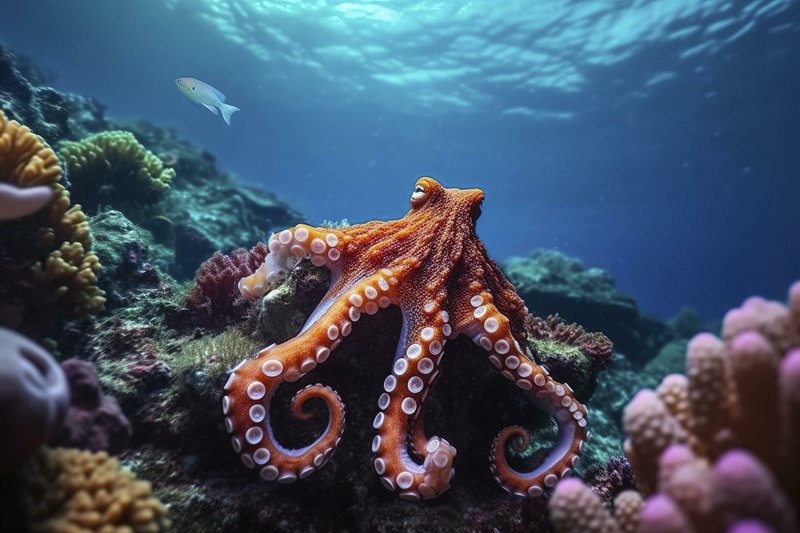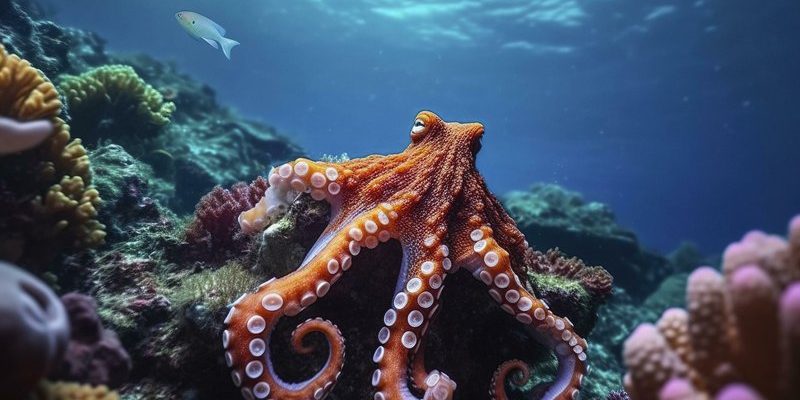
Have you ever watched an octopus glide effortlessly through the water, its tentacles trailing behind like a dancer’s flowing gown? These fascinating creatures are more than just intriguing to watch; they’re masters of survival in their underwater world. With their remarkable intelligence and unique physical abilities, octopuses captivate scientists and nature enthusiasts alike.
In this article, we’re diving deep into the world of octopuses. From their anatomy to their behavior, and the challenges they face in the wild, we’ll cover everything you need to know about these incredible cephalopods. So, grab a snack and get comfortable—you’re in for a treat of oceanic knowledge!
What is an Octopus?
The octopus is a soft-bodied, eight-limbed mollusk belonging to the order Octopoda. These sea creatures are celebrated for their intelligence, problem-solving skills, and adaptability. Unlike many other marine animals, octopuses do not have a hard shell; instead, they have a flexible body that allows them to squeeze into tight spaces and evade predators.
Typically found in oceans worldwide, octopuses vary significantly in size, ranging from the tiny octopus that can fit in the palm of your hand to the massive giant Pacific octopus, which can weigh over 100 pounds and span up to 14 feet! Despite their physical differences, all octopuses share a few common characteristics, including their unique ability to change color and texture, thanks to special pigment cells in their skin.
More than just a pretty face, octopuses are known for their impressive intelligence. In fact, they are considered among the most intelligent invertebrates. They exhibit behaviors that suggest problem-solving capabilities and even have been observed using tools, like coconut shells and stones, to hide or protect themselves.
Physical Description
Octopuses are instantly recognizable due to their eight long, flexible arms, which are lined with hundreds of sensitive suckers that help them interact with their environment. Each arm contains a complex network of neurons, allowing for precise movements and tactile sensations, which is quite different from other animals. When you think about it, an octopus can almost be seen as a moving extension of its brain!
In addition to their limbs, octopuses have a bulbous head, often called the mantle, where vital organs are housed. This body part can vary in color and texture, helping them blend into their surroundings. Some octopuses have developed the incredible capacity to mimic the patterns and colors of rocks, corals, and even other sea creatures. This skill is crucial for escaping predators or ambushing prey.
Another striking feature is their eyes, which are comparable in structure to human eyes and provide excellent vision. Surprisingly, unlike most marine animals, octopuses cannot see well at close distances, which adds another layer to their unique adaptations in hunting and evasion.
Habitat and Distribution
Octopuses thrive in various marine environments, from shallow coastal waters to the deep sea. They typically inhabit rocky crevices, coral reefs, and ocean floors, where they can easily find shelter and hunting grounds. The diversity of habitats allows different species of octopus to coexist, each adapted to their specific environment.
These creatures are found in oceans all around the globe, from the Atlantic to the Pacific. The common octopus (Octopus vulgaris), for instance, is widespread in tropical and temperate waters. Meanwhile, the giant Pacific octopus is unique to the North Pacific Ocean. Each species has its own set of unique behaviors and adaptations that make them suited for their local ecosystems.
Interestingly, some octopuses have also been spotted in brackish waters near river mouths, showing just how adaptable they can be. Their ability to navigate different habitats is a testament to their evolutionary success in the marine world.
Diet and Feeding Habits
Octopuses are carnivorous predators, primarily feeding on crabs, fish, and other small marine animals. They are skilled hunters, using their keen eyesight to spot potential prey from a distance. Once they’ve identified a target, they use their arms to grab it, employing the powerful suckers for a secure grip.
What’s fascinating is the way octopuses eat. They have a beak, somewhat similar to a parrot’s, which helps them break through the hard shells of crustaceans. After cracking open their meal, they inject venom through their salivary glands to subdue their prey, making it easier to consume. This unique feeding strategy highlights their evolutionary adaptations as effective hunters.
Octopuses also exhibit a behavior known as “stalking.” Instead of charging at their prey, they can move stealthily and carefully to avoid detection, enabling them to get closer before striking. This method shows how intelligent and calculated these creatures can be when it comes to feeding.
Reproduction and Lifespan
When it comes to reproduction, octopus life is both fascinating and a bit heartbreaking. Most octopus species are solitary and come together only for mating. After a male octopus mates with a female, the female lays thousands of eggs. She guards these eggs diligently, sometimes for months, without eating, which shows her commitment to ensuring the survival of the next generation.
Once the eggs hatch, the young octopuses are left to fend for themselves, as the mother typically dies shortly after the eggs are laid. This life cycle is intriguing and showcases the sacrifices made in the animal kingdom for the sake of offspring. The lifespan of an octopus varies by species but is generally short, ranging from 1 to 3 years for many species. However, larger species like the giant Pacific octopus can live up to 5 years.
The brief lifespan and the intensity of their reproductive cycle raise questions about their sustainability, especially in the face of environmental changes. As they face threats from overfishing and habitat destruction, understanding their life cycles becomes even more critical.
| Characteristic | Description |
| Size | Varies greatly; can range from 3 inches to 14 feet. |
| Habitat | Found in oceans worldwide; prefers rocky crevices and coral reefs. |
| Diet | Carnivorous; feeds on crabs, fish, and small marine animals. |
| Speed | Can swim quickly using jet propulsion when necessary. |
| Lifespan | 1 to 3 years on average; some species can live up to 5 years. |
Octopus Behavior and Intelligence
One of the most intriguing aspects of octopuses is their behavior. These creatures are known for their problem-solving skills and have been observed escaping from enclosures, solving puzzles, and even interacting with their environment in playful ways. For instance, some octopuses have been recorded using tools, such as gathering coconut shells to create shelters, which is quite rare in the animal kingdom.
Octopuses communicate in unique ways, often changing their skin color and texture to express their mood or intentions. This ability to camouflage not only aids in evading predators but also plays a role in mating and social interactions. Think of it as their way of using body language, much like humans do, to convey feelings without uttering a word.
Interestingly, research suggests that octopuses possess a form of learning called “observational learning.” This means they can learn from watching the behavior of others. This level of intelligence sets them apart from many other invertebrates and raises questions about their cognitive abilities and the nature of intelligence in animals.
Conservation Status
Unfortunately, many octopus species face threats due to human activities. Overfishing is a significant concern, as octopuses are often caught as bycatch in fishing nets, and their populations are declining in various regions. The destruction of marine habitats due to pollution and climate change also poses risks to their survival.
Some species, like the blue-ringed octopus, are particularly vulnerable due to their restricted habitats and specialized needs. Conservation efforts are underway to protect these remarkable creatures, but awareness and action are necessary to ensure their future. Programs aimed at sustainable fishing practices and ocean conservation are crucial in safeguarding the ocean and its inhabitants.
As individuals, we can contribute by being mindful of the seafood we consume and supporting initiatives that promote sustainable practices. The octopus, with its unique biology and behavior, deserves our protection and respect as a vital part of marine ecosystems.
FAQ
How do octopuses breathe?
Octopuses breathe through gills, which extract oxygen from the water as it flows over them. They take water in through their bodies and push it out through a siphon, a tube-like structure that also helps them move quickly if they sense danger.
Can octopuses change color?
Yes, octopuses can change color and texture thanks to specialized pigment cells called chromatophores. They use this ability for camouflage, communication, and even to show stress or excitement.
Do all octopuses have the same lifespan?
No, octopus lifespans vary widely based on species. While many live 1 to 3 years, larger species like the giant Pacific octopus can live up to 5 years, showcasing differences in growth rates and reproductive strategies.
Are octopuses dangerous to humans?
While most octopuses are not harmful, some, like the blue-ringed octopus, carry venom that can be lethal to humans. It’s essential to be cautious when encountering wild octopuses and to admire them from a safe distance.
How intelligent are octopuses?
Octopuses are considered among the most intelligent invertebrates, exhibiting behaviors like problem-solving, tool use, and observational learning. Their intelligence is comparable to that of some mammals, making them remarkable creatures to study.
What do octopuses do when they feel threatened?
When faced with danger, octopuses may use their ability to camouflage themselves, blending in with their surroundings. If that fails, they can expel ink to create a cloud that confuses predators, allowing them to escape safely.
How do octopuses communicate?
Octopuses communicate primarily through color changes and body language. Their ability to alter their appearance allows them to convey emotions and intentions, whether it’s mating displays or signaling aggression.
Can octopuses live in freshwater?
Octopuses are primarily marine animals, meaning they thrive in saltwater environments. While some species can tolerate brackish conditions, true freshwater habitats are unsuitable for them.
How many species of octopus are there?
There are about 300 recognized species of octopus, each with distinct characteristics and adaptations suited to their specific habitats. This diversity highlights the adaptability and evolutionary success of these remarkable creatures.
What do baby octopuses look like?
Baby octopuses, known as larvae, are tiny and resemble miniature versions of adults. They start as small, free-floating creatures before settling into their environment and growing into their adult forms over time.
Are octopuses social creatures?
Generally, octopuses are solitary animals. They prefer to live alone, only coming together to mate. However, some species have shown social interactions in controlled environments, such as aquariums.
What is the largest species of octopus?
The giant Pacific octopus holds the title for the largest species, with some individuals weighing over 100 pounds and having arm spans of up to 14 feet. Their size and strength make them awe-inspiring creatures of the deep.

